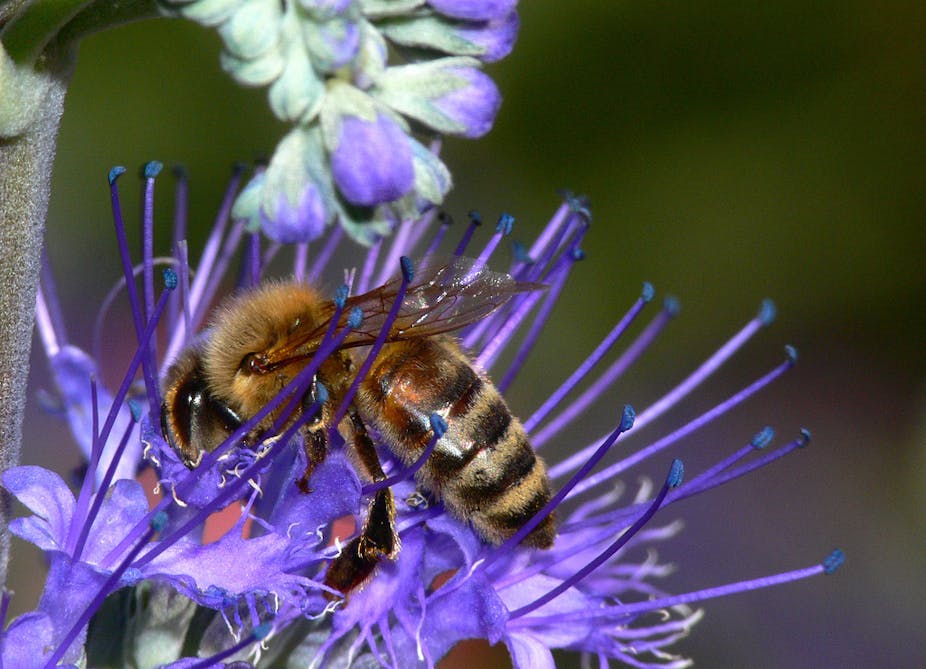In many countries there has been concern about a decline in honeybees. You may have even heard that honeybees face dangers so dire that their imminent decline threatens world food production, with potential consequences including widespread famine. Like any good story these ideas contain a germ of truth, but they have been taken well beyond the realm of reason.
Among the many millions of species on Earth, a few deserve to be thought of as super-species, both because of their evolutionary success (in numbers and capacity to expand into new territory) and their impact on human affairs. The European honeybee (Apis mellifera) is one of these.
The honeybee was first domesticated centuries ago and has since spread around the globe. They give us honey and wax, but most importantly they pollinate crops and in this way have a major role in food production. They’re successful as feral animals away from human care, and so contribute to crop pollination even in areas with no domestic hives.
Honeybees are social insects, living in colonies that can number 60,000 individuals. This social lifestyle is one reason they are so good at exploiting resources, because a discovery by one bee is communicated to thousands of others. But sociality also makes them vulnerable to disease, because infection rates in a crowded hive are very high.
Reports of honeybee decline have their origin in these disease problems, and two diseases deserve special mention: Colony Collapse Disorder (CCD) and the Varroa mite.

CCD is a syndrome rather than a specific disease, defined by sudden disappearance of most of the worker bees. It is thought that colonies under stress become more vulnerable than normal to diseases already in the environment, triggering the sudden collapse.
But this begs the question, what are the stressors? Because there remains no single causal explanation for CCD – and its apparent increasing frequency worldwide – there has been ample room for speculation.
Some have suggested that the deployment of genetically modified (GM) crops could be an important stressor. To date there is no evidence of a general association between GM crops and bee decline. Although bees could be exposed to elevated risk if the nectar or pollen of the GM crop contained exotic toxins, this risk is not fundamentally different from the risk posed by pesticides in general. It is expected that the risk to bees will be better predicted by the overall level of exposure to pesticides in the environment.
Some GM technology can lead to reduced pesticide application, which would likely benefit bees. On the other hand, some GM crops are deployed in systems with higher levels of chemical use, and these should be assessed with an eye on impacts to pollinators.
Bees are sensitive to insecticides, and need a year-round food supply from diverse sources. Therefore the global trend toward intensification of agriculture might contribute to CCD, because it requires higher inputs (like insecticides) and leads to more homogenised landscapes (larger areas of diminished flower diversity).

The Varroa mite is a better understood phenomenon. This mite, which is deadly to the European honeybee (though not to other bees), first emerged in Asia in the 1950s and has since spread around the globe. In 2000 it established itself in New Zealand, leaving Australia as the only Varroa-free zone in the honeybee’s world.
Beekeepers can protect their hives from Varroa with chemicals (another possible stressor), but Varroa eliminates defenceless feral bee populations. In this way there is a double impact on crop pollination. First, the cost of providing managed bees for pollination increases; second, the free pollination provided by feral bees decreases.
Australia, with its warm climate and abundance of nectar-rich plants (such as Eucalypts), is a haven for feral honeybees. As a consequence it is thought that Australian agriculture gets a particularly generous service of free pollination from feral honeybees. This free service will be all but lost when Varroa spreads to Australia. And I say when, not if, because it is widely accepted that we cannot expect to remain Varroa-free in the long term.
So what about food production? About three-quarters of the crop species used around the world get some benefit from insect pollination. But the world’s key staple crops are wind-pollinated, and therefore impervious to pollinator decline. Put another way, pollinator decline will not affect your bread or rice, but will affect your coffee and fruit salad.
Even those crops that benefit from pollination range from benefiting a little to complete dependence, so the whole analysis requires a crop-by-crop consideration.
While it is good to know that problems with bees are not going to cause widespread food shortages, it is important to recognise that growers of pollination-dependent crops do face challenges. And these growers range from large agricultural operations through to small-holder farmers in the developing world, who might depend on coffee (for example) as a source of cash income.

Is there evidence that pollinator shortages are beginning to bite? An analysis of crop trends since the mid-1960s shows that crops which depend on insect pollination experience more frequent low-yield years, and that while agricultural intensification has generally increased yield over time, the increase is less for pollinator-dependent crops. This “underperformance” suggests that while agricultural intensification increases many resources available to plants, the ecosystem service of pollination is not being adequately maintained.
Finally, while honeybees are a super-species and an integral part of our agriculture, they are not our only pollinators. Their key importance comes from the fact that we know how to manage them, and how to deliver them in great number when a crop needs pollinating. For the most pollination-dependent crops this is critical. But we also know that there are many other wild pollinators in the environment, and many crops benefit from their attentions.
We need to figure out how to keep a healthy beekeeping sector for crops that require managed pollination, but also foster landscapes that support wild pollinators for the other crops and native plants.

